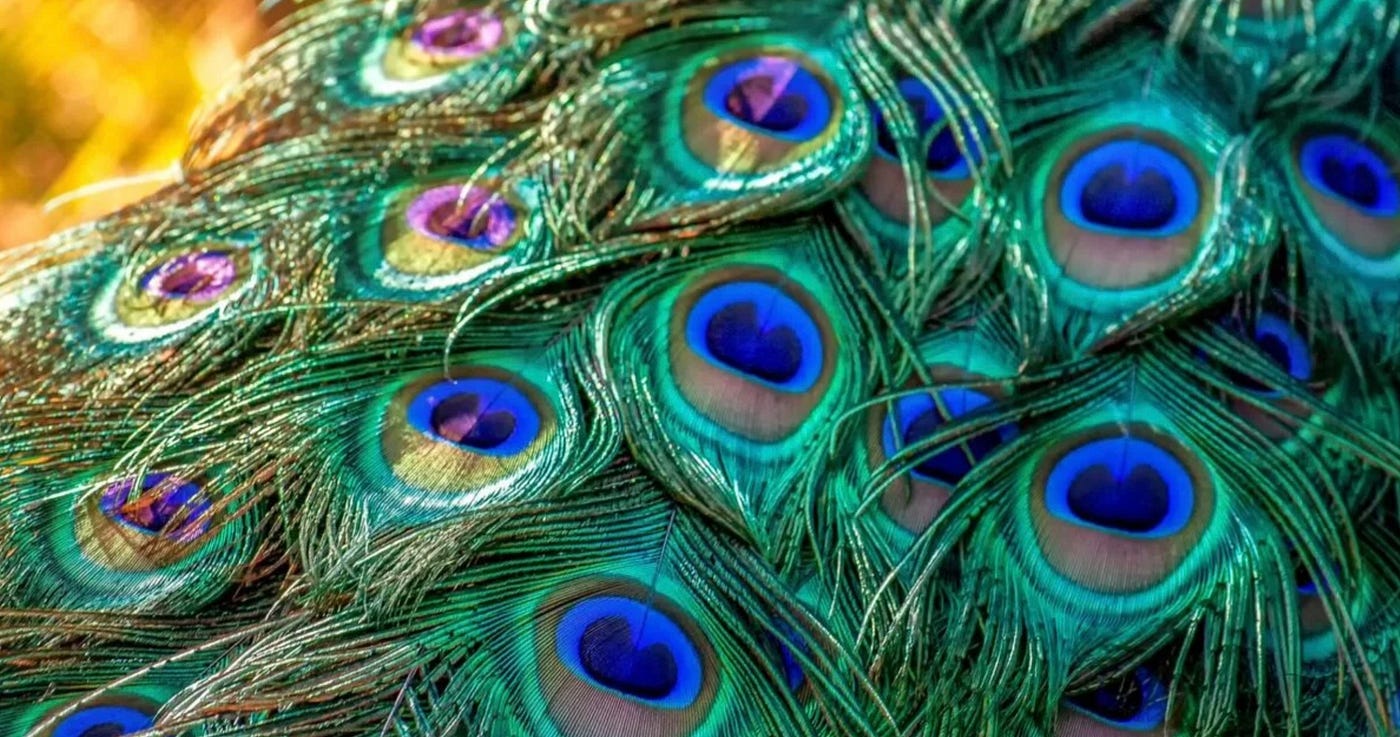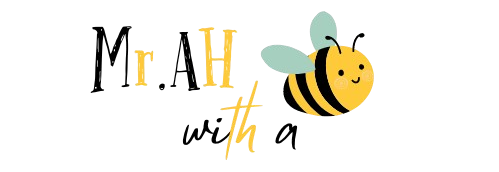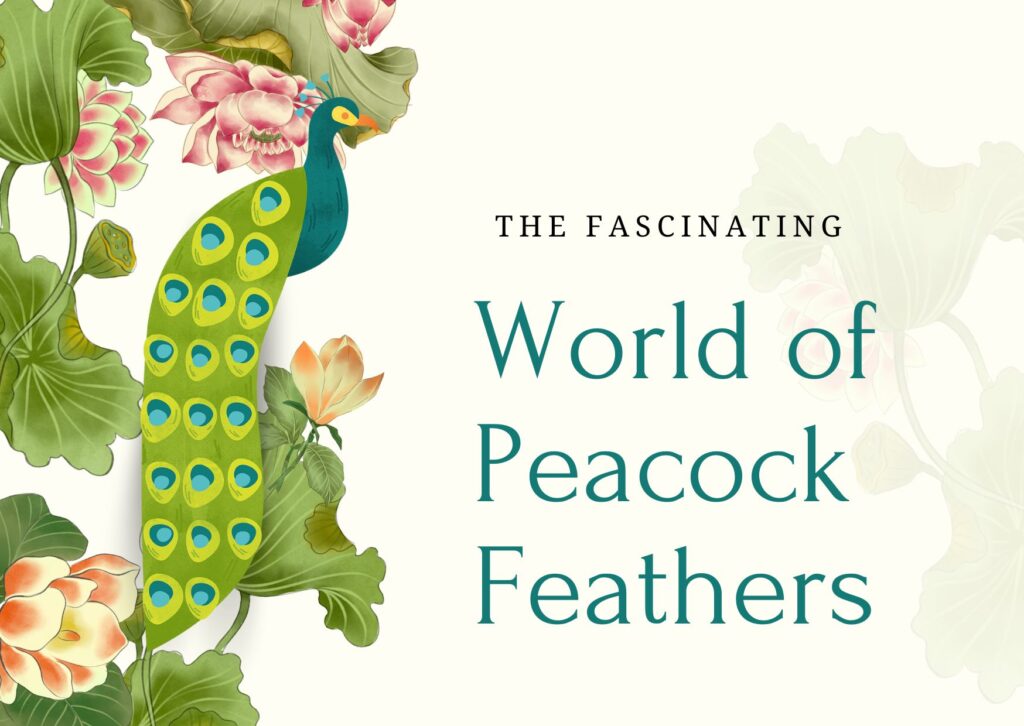Peacocks stand out as some of nature’s most stunning birds also known for their dazzling feather display. For centuries, humans have been fascinated by peacocks, often symbolizing beauty and royalty, and even representing eternity in various cultures. However, the aesthetic enchantment of a peacock’s feathers serves a complex biological function and often represents a rich social dynamic. This blog post will delve into various aspects of peacock feathers, addressing intriguing questions like why peacock fan their feathers, whether female peacocks do the same, and the evolutionary significance of their feathers.

The Anatomy of Peacock Feathers
A male peacock’s tail feathers, or train, are not only breathtaking to look at but also pretty interesting when you dig deeper. These feathers are iridescent, which means they change color as the angle of view or the angle of illumination changes. The train is made up of over 200 log feathers, each tipped with a cool eye-like pattern called an Ocellus.
The bright colors which range from electric blue to deep green and purple come from tiny structures that reflect light instead of pigments. This phenomenon is known as structural coloration, and you can find it in a lot of birds, insects, and even marine animals. Those tail plumage can get long, sometimes reaching up to six feet! Their size and weight are astounding, which allows the peacock to fan out its feathers without tipping over. The mix of color, shape, and movement in a peacock’s display is not just eye candy; it serves a purpose, too!
Why Do Peacocks Spread Their Feathers?

The main reason peacocks spread their plumage is for mating. Male peacocks (peafowls) fan out their trains during the courtship to attract the female peahens. This spectacular feather display is a key part of their mating dance, also known as the lekking display, where the Peafowl showcases his health, vitality, and genetic fitness. Essentially, the more impressive the feather spread, the better his chances of attracting a prospective mate. The train also plays a vital role in sexual selection.
Females tend to choose mates based on traits that include strong genes, and a larger, more vibrant train, which often represents a healthier peafowl. Interestingly, studies suggest that the peahens are attracted to specific features of the male’s train, like the size, number of ocelli, and symmetry of the plumage. But it’s not all about the looks. When a peacock shakes its feathers, it creates a rustling sound that draws attention. Recent research has found that the tail feathers produce low-frequency sounds, known as sonation (Clark & Feo, 2008), which are inaudible to humans but may be detected by females, adding another dimension to their courtship ritual.
Do Female Peacocks Spread Their Feather?

Unlike their male counterparts, female peahens lack elaborate tail feathers. Instead, they have more muted, brownish plumage that helps them to blend into their surroundings, especially while nesting. This ability to camouflage is crucial for survival, as peahens often stay behind to protect their nests and young from predators. While peahens don’t have the showy train of males, they can raise their shorter, less colorful tail feathers. Although they don’t use their feathers for courtship, some reports suggest that peahens spread their feathers when they feel threatened. This behavior is more about self-defense, as it can make them appear larger to potential predators.
The Evolutionary Significance of Peacock Feathers
Peacock plumage provides a fascinating example in evolutionary biology, especially regarding sexual selection and natural selection. Charles Darwin used the peacock’s extravagant tail to illustrate his theory of sexual selection, a subset of natural selection. The theory explains how some individuals gain an advantage over others of the same species and sex in reproduction. It suggests that certain traits evolve not for survival benefits but to enhance reproductive chances.
In the case of male peacocks, their feathers may hinder survival, especially when escaping predators, yet they significantly improve the male’s chances of passing on his genes. The trade-off between survival and reproduction is a classic evolutionary dilemma. Despite the drawbacks, such as increased visibility to predators, the reproductive benefits of having a striking train far outweigh these drawbacks. Males with more impressive displays typically father more offspring, ensuring that their traits are passed down through generations.
Cultural Significance of Peacock Feathers

Peacocks have long symbolized beauty, power, and immortality across numerous cultures. In Hinduism, the peacock symbolizes Lakshmi, the goddess of wealth and prosperity, with its feathers representing patience, kindness, and compassion. Greek mythology associates peacocks with Hera, the queen of the gods, depicting them alongside her as symbols of watchfulness and immortality.
In the arts and literature, peacock feathers frequently serve as a metaphor for beauty and pride. However, in Western superstitions, they symbolize vanity or arrogance, reflecting the peacock’s tendency to flaunt its feathers. Peacock feathers’ unique and vibrant beauty makes them a popular motif in fashion, home décor, and spiritual practices such as Buddhism, where they are often used in purification rituals
Thanks for reading, for more interesting articles please visit our homepage.



